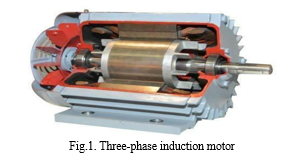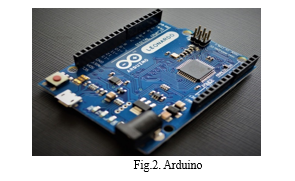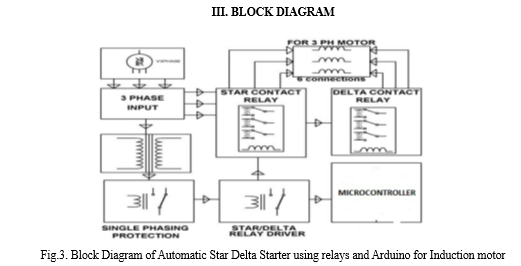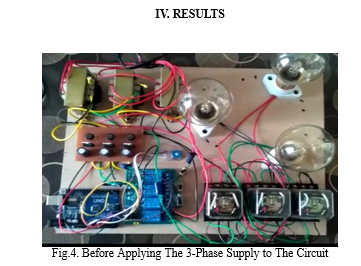Ijraset Journal For Research in Applied Science and Engineering Technology
- Home / Ijraset
- On This Page
- Abstract
- Introduction
- Conclusion
- References
- Copyright
Automatic Star Delta Starter with an Arduino and Relays for Three Phase Induction Motor
Authors: S. Saiganesh, U. Naresh, N. Ashrith, B. Snehith, K. Shiva Rama Krishna
DOI Link: https://doi.org/10.22214/ijraset.2024.58292
Certificate: View Certificate
Abstract
The most popular low voltage starters for 50 Hz industrial motors are either star or delta starters. Their purpose is to minimize the starting current that is supplied to the motor at the beginning of operation. Three contactors, a timer, and a thermal overload are typically used in the manufacturing of Star/Delta starters, which are used to run three-phase motors at 440 volts and 50 Hz AC mains supply. But in our project, we\'ve used the same to run a\\ 3-phase motor at 440-volt AC mains supply 50 Hz with a series of 12-volt DC relays, an Arduino-provided electronically adjustable timer, and a series of tiny circuit breakers. While maintaining its application for a 3-phase motor starting with a single phasing prevention, the interlocking arrangement of the relay coils and the electronic Arduino is all wired in low voltage DC of 12 Volt fed from an inbuilt DC power supply for safe handling of the starter during the study. The timer consists of an Arduino, whose output is sent to a relay to switch the mains supply from a three-phase star to a delta. Since the 3-phase motors could burn if one of the phases disappears while they are operating, the project additionally includes single-phase protection. In the case of a phase failure, the lamps\' output will be switched off. In addition, the project can be improved by utilizing thyristors in a firing angle control principle to soft start the induction motor, which would eliminate all of the star delta starter\'s shortcomings.
Introduction
I. INTRODUCTION
The induction motor holds a prominent position in the industrial sector owing to its diverse range of properties. Among them are features like easy control, robust construction, high efficiency, good power factor, and self-starting. Compared to other varieties, squirrel cage induction motors are utilized more frequently. Since the rotor bars are all connected to form a closed path, when the
motor is at idle, it simply appears as though there is a short-circuited transformer at the secondary side. This will cause the rotor bars to experience a significant current flow. Upon starting the motor, the stator draws a high current that is eight to ten times greater than the motor's rated current. It is essential to lower the voltage supplied to the motor before turning it on. Low voltage starting with induction motors is the goal of the project. Using star-to-delta conversion, this is accomplished. Within the 50Hz industrial motor industry, star/delta starters are perhaps the most widely used reduced voltage starters. The goal of Star Delta is to lower the motor's start current before eventually applying the motor's maximum load current. As the line voltage in a star connection is the root three times the phase voltage, the current in each phase is the same. Thus, if the motor is started in star mode, the voltage is decreased, which lowers the current. Additionally, when a motor is operated in a delta connection, the complete voltage is applied because the voltage in a delta connection is equal to the phase voltage. Three contractors typically supply the Star/Delta starter: an Arduino, a thermal overload, and an AC mains supply that operates a three-phase motor at 440 volts at 50 Hz. Conventionally, 440 Volt AC is used to wire all of the contactor coils in an interlocking pattern. With a series of 12 Volt DC relays operating in star mode and an electronically adjustable timer,

The electrical section of the three-phase induction motor as shown in the fig.1 consists of the fixed stator or frame, a three-phase winding supplied from the three-phase main, and a turning rotor. There is no electrical connection between the stator and the rotor. The currents in the rotor are induced via the air gap from the stator side. The stator and rotor are made of highly magnetizable core sheets providing low eddy current and hysteresis losses.
The project is intended to start a Three-phase motor at 440 volt AC mains supply of 50 Hz. To switch the motor connections from star to delta with a time delay, a group of relays is utilized. The project comes with six lamps in a three-phase motor, meaning that three lamps will run when the motor is connected in a star configuration, and all six lamps will run when the motor is switched from a star to a delta configuration.
Three contactors, an electromechanical timer, and a thermal overload are typically used in the construction of a Star/Delta starter, which powers a three-phase motor at 440 volts and 50 Hz AC main supply. Traditionally, a set of 5-volt DC relays, a UNO timer, and a 440-volt AC main supply 50Hz are used to wire the interlocking arrangement of all the contactor coils. To prevent a single phase starting in a three-phase motor, the relay coil interlocking arrangement and the UNO are wired in low voltage DC of 5 volts, fed from an integrated DC power supply. The project will be tested with a set of lamps for each phase because utilizing a three-phase induction motor would be costly.
The lamps would glow dimly during star operation, indicating a supply voltage of 440/sqrt (3), and fully illuminate during delta condition, following the timer's operation, indicating a full supply voltage of 440 volts. When the UNO is in the timer mode, its output is sent to a relay, which switches the primary supply from a three-phase star to a delta. Since three-phase motors burn if one of the phases fails while they are operating, the project also includes single-phasing protection. In the event of a phase failure, the lamp's output must be stopped.
There are different components used in this project they are Capacitor, Filter, Voltage Regulator, Rectifier, Relay, Transformer, Two Contact Relay, and Lamps. Additionally, there are several drawbacks to the star delta beginning, such as the delay in transitioning between the star and delta connections. Starting with the understanding that there would be a delay in switching connections is crucial. With the use of the controller's internal timers, this project aims to automate the motor's star and delta connections. The timer switches between the connections using microcontrollers to make it feasible. The reason why it's crucial to switch connections is that a star connection can supply high current, which can damage coils and shorten motor lifespans when used when the motor is operating.
To start a high-power induction motor, an automatic star delta starter is necessary. On the other hand, because a large starting torque is needed, a high-power induction motor cannot be started with a DOL starter. Therefore, we need to use a different starter that can produce a lot of starting torque. Here, we're utilizing a star-delta starter, which uses a star connection to start the motor and a delta connection to drive it. The star delta starter was selected because it operates in a delta connection and offers a high beginning current during the start condition.
II. TECHNOLOGY
The Arduino UNO is an open-source microcontroller board created by Arduino. cc that is based on the Microchip ATmega328P microprocessor.
The board has sets of input/output (I/O) pins, both digital and analog, that can be interfaced to different expansion boards (shields) and other circuits. With the use of a type B USB connector and the Arduino IDE (Integrated Development Environment), the board's 14 digital and 6 analog pins can be programmed. It takes voltages between 7 and 20 volts, however, it can be powered by an external 9-volt battery or a USB cable.
"Uno" signifies "one" in Italian and was selected to commemorate the launch of the Arduino Software (IDE) 1.0. The reference versions of Arduino were the Uno board and version 1.0 of the Arduino Software (IDE), which have since been updated to later versions. The Uno board serves as the platform's standard model and is the first in a line of USB Arduino boards. The Arduino Uno's ATmega328 has a boot loader pre-programmed into it, allowing fresh code to be uploaded without the need for an additional hardware programmer. The original STK500 protocol is used for communication.
In this project, "Automatic star delta starter using a relay for three phase induction motor," an Arduino serves as a timer. Pin 2 is used for start, while pin 3 is utilized for stop.
Pins 8 and 9 are utilized for delta and star connections, respectively. The motor is started on PIN 2 using a star connection, and after 30 seconds, it switches to a delta connection, which is halted by PIN 3.

The above Fig.2 is an Arduino UNO clone an easy-to-use, Open-source controller. Simply connect to a PC and begin using it. The Arduino UNO Clone is a microcontroller board based on the ATmega328.It has 14 digital input/output pins of which 6 can be used as PWM output and 6 Analog inputs, a 16MHz ceramic resonator, a USB connection, a power jack, an ICSP header, and a reset button. It contains everything needed to support the microcontroller; simply connect it to a computer with a USB cable or power it with an AC-to-DC adapter or battery to get started. The Uno can be powered via a USB connection or with an external power supply. The power source is selected automatically. External (non-USB) power can come either from an AC-to-DC adapter (wall-wart) or a battery. The board can operate on an external supply of 6 to 20 volts. If using more than 12V, the voltage regulator may overheat and damage the board. The recommended range is 7 to 12 volts. The Uno has 6 Analog inputs, each of which provides 10 bits of resolution (i.e. 1024 different values). By default they measure from ground to 5 volts, though is it possible to change the upper end of their range using the AREF pin and the Analog Reference function?
The Arduino Uno features a set of digital and analog input/output pins that allow it to interact with the external world. Here's a breakdown of the pins:
- Digital Pins (D0-D13): These pins can be configured as either inputs or outputs. They operate at logic levels of either HIGH (5V) or LOW (0V).
- Analog Pins (A0-A5): These pins can be used to read analog voltage levels using the built-in ADC. They can also function as digital inputs or outputs.
- PWM (Pulse Width Modulation) Pins: Some digital pins (D3, D5, D6, D9, D10, and D11) support PWM, which allows for analog-like output by varying the duty cycle of the signal.
- Power Pins: The Arduino Uno provides pins for power, including 5V, 3.3V, and Ground (GND).
III. BLOCK DIAGRAM

In the block diagram above, the first Three single-phase transformers receive a Three-phase supply of 415 volts AC. One of these Transformers outputs 230/12 volts, which are then fed to the printed circuit board through three sets of bridge rectifiers to activate the 12 Volt DC relays. The microcontroller is also utilized to drive the 7809 Voltage Regulator, which produces a 9 Volt DC output that is supplied to the Arduino supply via two additional transformers. These transformers are used to drive the delta and star-connected relays, which are controlled by the microcontroller to operate with a three-second delay. This causes the motor to operate in delta mode following the predetermined time delay instead of star mode at first. Only 1/√3 of the rated current is allowed, and the motor windings are operated from the high inrush current during motor startup. Following the predetermined amount of time, the motor is moved to delta mode, which permits full load current. The suggested project uses a star-to-delta conversion to supply low voltage to induction motors. In essence, star-delta is used to reduce the motor's starting current rate before applying the entire load current. In this project, three-phase motors are replaced with six lamps, one phase motor with two lamps, and a time delay and set of relays to assist in switching the motor connections from star to delta. In delta mode, this is electrically controlled using a timer. In star mode, a mechanism is utilized that begins a three-phase motor at 440V AC mains supply 50Hz with a set of 12V DC relays. When the lamps are first turned on, or in star mode, they glow dimly. When they are turned on by a timer, however, they glow brightly. This shows that while there was a full voltage supply of 440V in delta mode, the supply voltage in star mode was 440 roots of 3. The timer's component, a 555 operating in mono-stable mode, feeds its output to a relay, which converts the main supply from a three-phase star to a delta.
IV. RESULTS

In the above Fig.4. The Figure shows the Various Components of the project and all the Components are placed on the board. The Connections are given as per the Block diagram. The main component is Arduino (Microprocessor) which controls the circuit with a time delay The figure also shows that it is before applying the 3-phase supply to the circuit. All connections should be connected properly without any prevention of shock. Star-Delta starter generally comprises contractors and a UNO as a timer to enable the starting of the induction motor in star mode and then switch over to delta mode after the time delay set in the UNO. The project uses three step-down transformers the primary of which is connected in star mode while their secondary develop filtered DC after passing through respective bridge rectifiers and voltage regulators with filter capacitors. In this project, we use voltage regulators to take a 5V DC supply for UNO.
The circuit also has a potentiometer which controls the Arduino performance. the Arduino has mainly reduced the timing performance of the starting of the induction motor. The voltage regulator controls the voltage. In this we have used the rectifier which converts the AC (Alternating current) to DC (Direct current) and this DC supply is given to the Arduino which is controlled by a trimmed potentiometer. In this Arduino, the Arduino code will be compiled and a set of time delays will be set in the Arduino. The relays are also used to sense the fault in the circuit. The three 8-pin relays are placed on the board to control the delta operation.

V. FUTURE SCOPE
The primary purpose of a star delta starter is to allow the motor to start, with the motor windings arranged in a star pattern about the supply voltage. This means that the voltage provided to each motor winding for the star delta starter is decreased by a factor of 1*sqrt(3) = 0.58. This relationship represents about 30% of the delta values. It is the easiest and least expensive technique to start the motor when compared to lower voltage approaches. An automatic voltage fluctuation protector system has been put in place to protect induction motors. It is also readily commercializable.
Conclusion
In this project, we used Arduino to create an autonomous star delta starter for an induction motor. We may conclude that this sort of beginning is used for low to medium-voltage applications since this system offers a solution for a higher starting current. Since the starting current for three-phase induction motors is reduced by three to four times compared to a straight online starter, this is the least expensive method of doing so. Through the use of relays and the Arduino circuit, we can simply execute this method of starting the motor, as demonstrated by this project. The relay\'s method of connection prevents the motor from experiencing a single phasing. The implementation involved utilizing an induction motor starter; however, in our project, the induction motor is utilized to power six bulbs. Although direct-on-line methods also use star-delta starters, automatic star-delta starters automatically switch between modes with the use of modifiable Arduino code. When the code first switches from star to delta operation mode, it will set a finite number of seconds. Primarily, this method offers protection against high beginning current for the motor; nevertheless, the motor will not be adequately protected when using the DOL method. The difference in the number of bulbs burning indicates the monitored voltage display.
References
[1] J. Nagrath, D. P. Kothari, “Electrical Machines”, 2nd Tata McGraw Hill, New Delhi [2] K. Sundareswaran and B.M. Jos. Development and Analysis of Novel Soft-Starter/Energy-Saver Topology for Delta-Connected Induction Motors, IEE Proc.-Electr. Power Appl., 152(4) , 2005. [3] G. C. Soukup “Cause and analysis of stator and rotor failures in three-phase squirrel cage induction motors”, IEEE Trans. Ind. Applicat, vol.28, no.4, pp.921-937 1992. [4] Kato, Masakazu, Orikawa, Koji, Itoh, Jun-ichi, Saitoh, Noboru. Fast Starting Method Using Both Inverter And Delta-Star Starter For Weaving Machine Drive Systems, IEEE 1st International Future Energy Electronics Conference (IFEEC) -Tainan, 2013. [5] AssfaqHussain,’ElectricalMachines”, Second Edition, Publication Dhanpatrai and Co-oprative. [6] AkshayRohilla, Harish Chand Joshi, AnuragNegi, ”Star Delta Starter of Induction Motor”, IJIRT, Volume 1Issue 6, ISSN:2349-6002, 2014. [7] Henk de Swardt, Star Delta starting and dual Voltage motors explained, Marthinusen & Coutts (Pty.) Ltd. A division of Savcio Holdings (Pty.) Ltd. Rev, 2007. [8] IEEE standard test procedure for polyphase induction motor and generators, IEEE standard 112-1996, New York, May 1997. [9] Sunil.S.Rao,” Switchgear Protection and power system”, Khanna Publication [10] Suvra, G, Fuzzy Logic Based Soft Starting of Induction Motor with Current Control, National Institute of Technology, Rourkela, 2014. [11] Thompson, S P, 2017. Polyphase Electric Currents and Alternate-Current Motors”, (1st edition.). London: E. & F.N. Spon. P. 261, 1895. [12] Ferraris, G. Atti della Reale Academia delle Science di Torino”. XXIII: 360-375. 1888. [13] Babbage, C; Herschel, J.F.W. Account of the Repetition of M. Arago’s Experiments on the Magnetism Manifested by Various Substances during the Act of Rotation. Philosophical Transactions of the Royal Society,2017. [14] Terrel C and Wiltord SEd, American Electricians Handbook, Eleventh Edition, McGraw Hill, NEW York, ISBN 0-07-013932-6 pp. 78-150 through 7-159. [15] Nevelsteen, J and Aragon, H. Starting of large motors-vol.25,pp.1012-1018/Nov, 1989.
Copyright
Copyright © 2024 S. Saiganesh, U. Naresh, N. Ashrith, B. Snehith, K. Shiva Rama Krishna. This is an open access article distributed under the Creative Commons Attribution License, which permits unrestricted use, distribution, and reproduction in any medium, provided the original work is properly cited.

Download Paper
Paper Id : IJRASET58292
Publish Date : 2024-02-04
ISSN : 2321-9653
Publisher Name : IJRASET
DOI Link : Click Here
 Submit Paper Online
Submit Paper Online

